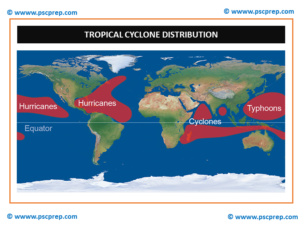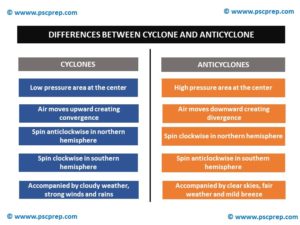CYCLONES AND ANTICYCLONES
Cyclones and Anticyclones: Description
Cyclones and anticyclones are the major forces that shape everyday weather. Understanding how these systems behave is critically important to accurate meteorological forecasting.

Cyclones and Anticyclones: How Cyclones work
Cyclones are areas of low pressure. Since air moves from areas of high pressure to low pressure, cyclones produce a convergence at the surface. This converging air is forced upwards into the atmosphere, creating a divergence aloft. As warm, moist air is sucked into the low and forced aloft, it produces an unstable atmosphere. This warm, moist air cools, condenses and forms storm clouds. That is why the word cyclone is almost synonymous with the word storm which denotes a period of heavy rainfall over a specific area. Cyclones can be tropical in nature, such as a hurricane, or a low-pressure system over a land mass, such as the United States. In tropical belt cyclones originate at low latitudes in the oceans from thermal convection. It develops into a violent whirling air mass having horizontal dimensions of 150 to 500 km and wind speed exceeding 120 km/hour. The tropical revolving storms of this type are called Hurricane in general but are known by name Cyclone in India and Typhoons in Far East region. The cyclones which are formed in mid-latitude belt (30° to 60°) are called extra-tropical cyclones. They form along the boundaries between warm and cold air masses (The boundary is known by a technical name ‘Front’).
Cyclones and Anticyclones: Effects of Cyclones
In general, cyclones are associated with clouds, rain and thunderstorms. They produce steep pressure gradients, creating strong surface winds. Over the United States, cyclones will draw in warm, moist air from the Gulf of Mexico, creating a warm front. This generally produces light, steady rain to the northeast of a low, ahead of the warm front. Cyclones also draw in cold air from the north. This colder air forms a cold front, which collides with the warm, moist air to produce showers and thunderstorms to the southeast of a low, ahead of the cold front.
Cyclones and Anticyclones: How Anticyclones work
Anticyclones are areas of high pressure. The sinking air spreads out when it reaches the ground, producing a divergence at the surface. Aloft, air rushes in to fill the void, creating a convergence aloft. Anticyclones produce a stable atmosphere. Anticyclones, or highs, are also referred to as blocking highs because they tend to force areas of low pressure to travel around them. For example, a hurricane (tropical cyclone) that encounters an area of high pressure will be deflected around the cyclone. Blocking highs have spared the East Coast of the United States from many hurricane strikes, pushing them out over the Atlantic Ocean.
Cyclones and Anticyclones: Effects of Anticyclones
In general, anticyclones are associated with fair weather. As the air sinks, it warms and dries. This produces clear skies and increases the air’s ability to transmit radiant energy. In the summer, this means high temperatures due to solar heating of the surface. During the winter, this means low temperatures due to the radiation of heat from the surface into space. Cyclones typically have low-pressure gradients, producing light, variable winds at the surface. Cyclones tend to be slow movers, providing extended periods of fair weather. During the summer and fall, a Bermuda High can establish itself off the eastern coast of the U.S. for long periods of time, producing high temperatures in the Southeast and blocking hurricanes.
Differences between Cyclones and Anticyclones: Pressure
The primary difference between the two types of weather systems is their atmospheric pressure. Cyclones represent areas of low pressure, while anticyclones represent areas of high pressure.
Differences between Cyclones and Anticyclones: Direction
Cyclones spin in a counterclockwise direction in the Northern Hemisphere and clockwise in the Southern Hemisphere. Anticyclones spin in a clockwise direction in the Northern Hemisphere and counterclockwise in the Southern Hemisphere.
Differences between Cyclones and Anticyclones: Weather
In general, cyclones are associated with clouds, rain and thunderstorms. In general, anticyclones are associated with fair weather.


The package consists of summaries of curated sources for studying the most critical subjects of UPSC in the most comprehensive manner. The summaries are prepared in consultation with exam toppers and serving/retired civil servants along with our own team of experts who ensure that you refer to the most relevant content in your preparation journey.
In the current exam scenario the bigger challenge is not the lack of material but the availability of excessive material that often confuses aspirants. Hence this package is our endeavor to minimize wastage and maximize utilization of an aspirants precious time. What will also be of interest to you is the fact that unlike many other institutions we have prepared the whole package in an editable format so that you can easily edit, append, delete the notes to suit your current preparation.
Quality of the notes is our most important focus. Coming from the house of PSCPREP you can be rest assured that the notes are of the topmost quality.